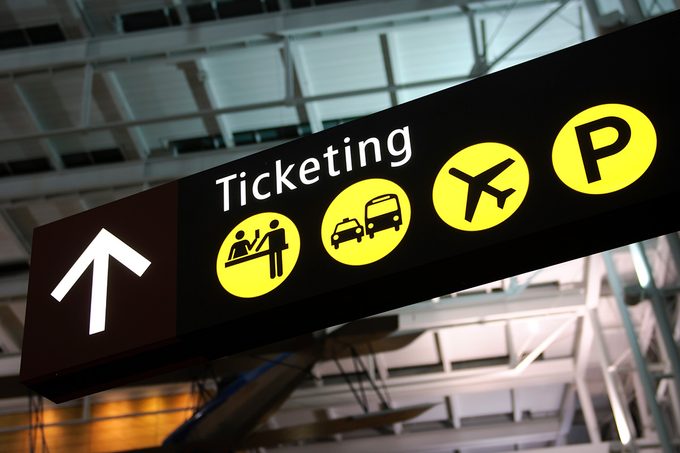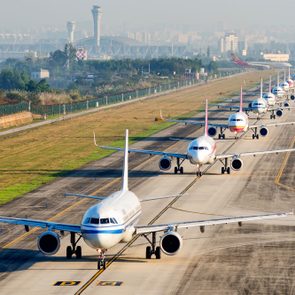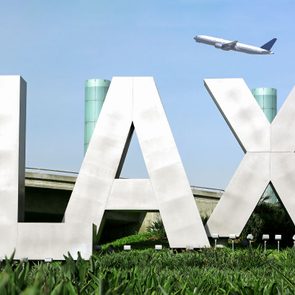Understanding airport pictograms can have you navigating the terminal like a seasoned jet-setter rather than a dazed and confused tourist

Here’s What These Common—But Confusing!—Airport Signs and Symbols Mean

Over the years, I’ve transited through scores of airports around the world, from Scandinavia’s chic, minimalist terminals to the lively, sometimes chaotic hubs of Central America. But one thing they all have in common? Those pictogram-puzzle signs. While they seem simple enough to decipher and don’t require knowing a local language, they still manage to run the gamut from crystal clear to completely confounding. Racing through an airport to make a flight or locate help with lost luggage definitely isn’t the ideal time to get tripped up by one of the more cryptic icons. Read on as Reader’s Digest decodes wayfinding directional and informational signage, from simple to tricky, so you don’t have to.
Get Reader’s Digest’s Read Up newsletter for more travel, tech, cleaning, humor and fun facts all week long.
Why do airports use so many symbols?

Airports are true melting pots, where travelers of all backgrounds, languages and abilities converge. So communicating important information that all people can understand at a glance can be quite a challenge. In the United States, the Federal Aviation Administration (FAA) provides airports with general signage recommendations, but there is no set standard. The International Organization for Standardization (ISO) and the International Civil Aviation Organization (ICAO) also give airports wayfinding and signage guidelines, but they are only suggestions. Airports are free to adapt them however they choose, such as using local languages or cultural symbols.
The bottom line: There’s no convenient, universal manual for travelers to use to decipher signs. Luckily, airport planners do their best to make the symbols as easy to intuit as possible. On the runway? There’s an entirely different set of symbols that are less relevant for travelers but that pilots and air traffic controllers definitely need to know.
Is signage always a specific color?
Most airports follow a standardized color scheme with signage, thanks to industry guidelines—but frequent flyers know it can definitely vary by destination. Despite these differences, there are some common themes. Directional signs are often bright yellow and jet black, creating high contrast for maximum visibility and readability. Informational signs, such as those for currency exchange or passport control, tend to be white-on-blue, while white-on-red in many cases is used for emergency alerts or prohibition signs, like those for no smoking or no entry.
Common symbols and their meanings
Arrivals and departures

Whether you’re coming or going, these icons are the ones you’ll likely see the most. Arrivals are typically represented by a plane angled downward, or landing, while departures show a plane taking off, or slanted upward.
Flight connections
See a sign with two airplanes heading in opposite directions? That’s the passengers’ cue for flight connections. This sign guides you to airport transit or other terminals to catch ongoing flights. Some versions might sport two planes linked with a dotted line, or a figure with a suitcase.
Check-in
The sign for check-in comes in multiple styles: old-school versions include a person with a suitcase standing in front of a figure behind a counter, or perhaps a suitcase on a scale. Newer ones might have a traveler at a self-check-in kiosk.
Security screening
Airport security checkpoints are definitely not the best part of a journey, but it helps to know how to get there so you can move on. Common security icons include an officer figure, an officer checking a suitcase or a passenger inside a rectangle that symbolizes a metal detector.
Border Protection and Customs
Like with security checkpoints, when it’s time to head through passport control, you often should be on the lookout for an officer icon—usually one wearing an officer’s cap and holding up a passport. Customs signage may also show a suitcase inspection, or a traveler with luggage with an officer behind a counter.
Baggage claim

The classic baggage claim sign? Most often one of those vintage suitcases with a handle perched on a line representing a conveyer belt. Maybe they should also include a clock, since it seems like checked bags always take forever to come out!
Elevators
Unless you want to get in a quick StairMaster session, most airports have elevators. Look for a box with one or more figures inside and arrows pointing up and down to represent movement. That’s your sign to skip the workout.
Restrooms
One of the most universal (and appreciated) signs at the airport, the restroom icon features simplified male and female figures. Both together on a sign often means a unisex or all-gender restroom. Family bathroom signs might feature an adult with a child, or a figure changing a baby’s diaper.
Shower facility
Most people will probably never take a shower at an airport, but airport showers actually do exist, usually in international terminals or lounges. To find the shower facility, look for signage with a figure standing under falling water, or a shower head with flowing water.
Money exchange
Whether you’re in need of euros, yen or just a few extra bucks, currency exchange signs are often marked by world currency symbols, a dollar sign surrounded by circular arrows, or coins, bills and other general symbols representing cash.
Lost and found
There’s nothing worse than losing an item while traveling, so it pays to know the lost-and-found symbol. Many airports use a suitcase icon—or the commonly misplaced glove and umbrella—with a question mark as the go-to icon for the service.
Lounge access
Travelers who want to trade the hubbub of the airport for some peace, Wi-Fi and wine often head to airport lounges. Icons might feature a reclining traveler, a comfy seat with a drink, or a sofa—occasionally accompanied by the word “Lounge.”
Ground transportation
When it’s time to hit the road, look for ground transportation icons that are refreshingly literal: the front of a shuttle bus, a taxi (often shown with a small rectangle, or roof sign, on top), or a train on a track. In many airports, rideshares like Uber and Lyft have their own dedicated pickup zones, which might be indicated by rideshare app logos, a car with a map pin icon, or a smartphone and car.
Car rental
Need your own set of wheels? Rental services are most often depicted by a vehicle with a key floating above or beside it.
Information desk
Totally lost or need information? There’s no shame in asking for aid—just head to a help point, marked with an “i” or a question mark.
RELATED:
- New Study: If You Fly Out of This Airport, Be Prepared to Wait Around 50 Extra Minutes Before Takeoff
- You’re Spending a Lot More at the Airport Than You Think—Here’s How Much
- The New Gen Z Travel Trend You Won’t Want to See at the Airport
Why trust us
Reader’s Digest has published hundreds of travel stories that help readers explore the world safely, easily and affordably. We regularly cover topics such as the best places to visit (and the best times to visit them), tips and tricks to zoom through airport security, flight-attendant secrets, hotel-room hacks and more. We’re committed to producing high-quality content by writers with expertise and experience in their field in consultation with relevant, qualified experts. We rely on reputable primary sources, including government and professional organizations and academic institutions as well as our writers’ personal experiences where appropriate. We verify all facts and data, back them with credible sourcing and revisit them over time to ensure they remain accurate and up to date. Read more about our team, our contributors and our editorial policies.
Sources:
- International Civil Aviation Organization: Current Aviation Symbols Standards
- National Renewable Energy Laboratory: “The Evolution of Wayfinding Within Airports”



